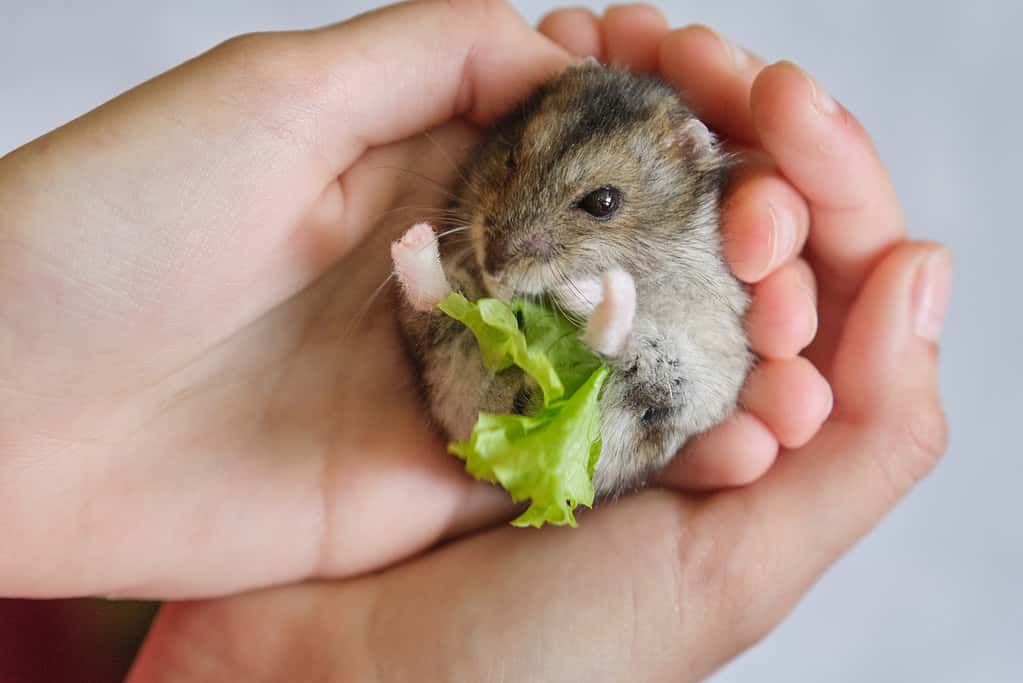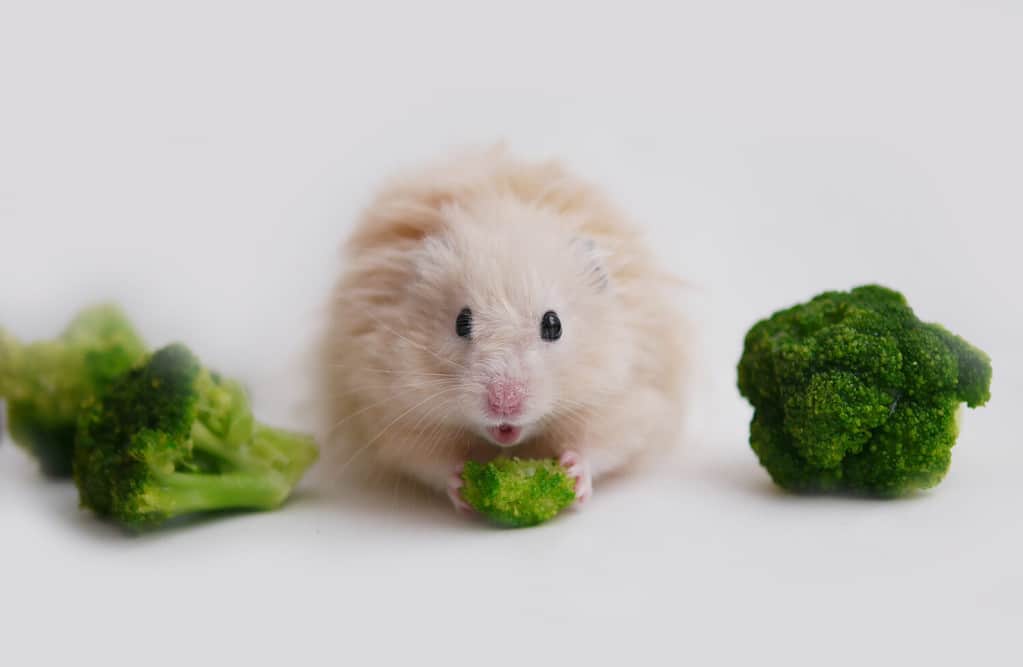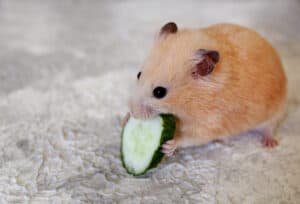Hamsters are small omnivorous rodents that thrive on a varied diet. In the wild, hamsters are natural foragers and eat a mixture of seeds, grains, insects, and leafy greens. When choosing which foods to include in your pet hamsters’ diet, you ideally want to replicate their wild diet. Aside from a commercial pellet or seed mix made for hamsters, you can offer them natural foods like leafy vegetables.
Feeding Lettuce to Hamsters

Hamsters can eat lettuce in moderation, ideally no more than three times a week.
©Valeriy_G/iStock via Getty Images
Lettuce is one of the most popular leafy vegetables that is safe for hamsters to eat in moderation. However, not all types of lettuce are created equal. Some types are more nutritious than others, and not all of them are recommended for hamsters to eat.
Safety
Organic lettuce meant for human consumption is generally safe for hamsters to eat. Lettuce is not toxic to hamsters and can easily form part of your hamster’s healthy and balanced diet. Most hamsters will readily accept lettuce as an occasional treat, but some hamsters will only have a few nibbles before discarding it.
All species of domesticated hamsters can safely eat lettuce with few adverse health effects. They include the Syrian, winter white dwarf, Campbell dwarf, Chinese, and Roborovski hamster. Hybrid dwarf hamsters who are a mixture of the two dwarf hamster species can also safely eat lettuce.
The only time lettuce might be unsafe for hamsters is if it contains chemicals, or dirt, or is fed in excess. Some store-bought lettuce may have traces of harmful herbicides and pesticides that were used during the growth process. Those chemicals can be dangerous for hamsters to ingest, even in small quantities that would be safe for humans to eat.
Furthermore, hamsters should not be eating too much lettuce at once. Lettuce has a high water content and might cause your hamster to experience a bit of an upset stomach. This could cause your hamster to have a bout of diarrhea for one or two days. It is important to stop feeding your hamster lettuce if you notice changes in their stool and behavior. If their abnormal behavior continues, don’t hesitate to take them for a checkup at an exotic veterinarian.
Is Lettuce Nutritious for Hamsters?
Lettuce is a source of vitamins and minerals that can make it a beneficial addition to your hamster’s diet. They offer hamsters vitamins A, C, and K, which are essential for a hamster’s basic bodily functions. Lettuce is also rich in minerals like potassium, calcium, iron, and magnesium. However, most hamsters should be getting most of their vitamins and minerals from a balanced species-appropriate diet.

The darker types of lettuce are usually more nutritious, and therefore better to feed to your hamster.
©2158916329/Shutterstock.com
Although lettuce is safe for hamsters to eat, it should only be offered as a snack in moderation. Vegetables like lettuce should never be fed in replace of a hamster pellet or seed mix, since it is nutritionally incomplete.
Preparation
Any lettuce that you feed to your hamster needs to be organic and free from pesticides and herbicides. Regardless, you will still need to prepare the lettuce for your hamster even if the packaging lists it as “ready to eat”. You will need to wash the lettuce under warm water to remove leftover dirt and debris. The lettuce can then be dried using a paper towel and broken into sizeable pieces for your hamster to eat.
Never feed your hamster lettuce that has been prepared with seasonings or sauce. This means that lettuce found in your food is unlikely to be safe for hamsters to eat. While cooked lettuce is safe for hamsters, it needs to be fed plain.
Feeding Guidelines
According to the Animal Humane Society (AHS), vegetables like lettuce should only be offered in bite-sized pieces two to three times a week. Any new foods should be slowly introduced into your hamster’s diet to avoid upsetting their stomach. The lettuce should be removed from their cage if they do not eat it within 30 minutes to prevent spoiling.
With around five different species of hamsters being kept as pets, not all of them are the same size. This will affect the size of the lettuce they can eat. A general rule of thumb is to feed the larger species like the Syrian and Chinese ½ to ⅓ a teaspoon of lettuce. The smaller species like the Winter White, Campbell, and Roborovski hamsters should only be fed ⅓ teaspoon of lettuce.
6 Types of Lettuce Hamsters Can Eat
There are many different types of lettuce that are safe for hamsters to eat. However, Romaine and butter lettuce are preferred for their higher nutritional value. While iceberg lettuce is safe for hamsters to eat, it should be avoided because of its lower nutritional value and high water content at around 96%. Most hamster owners stick to the rule that the darker the lettuce is, the more nutritional it is.

Leafy green vegetables can be a healthy addition to your hamster’s diet.
©tanya_morozz/Shutterstock.com
Below are the six main types of lettuce that hamsters can safely eat.
- Romaine lettuce
- Red or green Batavia lettuce
- Red leaf lettuce
- Butter lettuce
- Bibb lettuce
- Little gem lettuce
Other Hamster-Safe Leafy Greens
Other leafy greens that are similar to lettuce which hamsters can eat include spinach, watercress, and arugula. They can be offered up to three times a week in small portions alongside your hamster’s main diet.
In Conclusion
Organic lettuce is safe for hamsters to eat as a healthy occasional snack. You ideally want to feed hamsters Romaine or butterhead lettuce, although most varieties of safe. Lettuce should only be offered to hamsters two to three times a week, and in pieces no larger than ½ teaspoon for most species.
The photo featured at the top of this post is © Valeriy_G/iStock via Getty Images
Thank you for reading! Have some feedback for us? Contact the AZ Animals editorial team.







